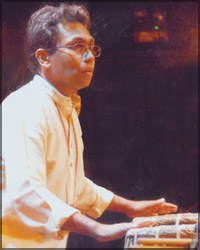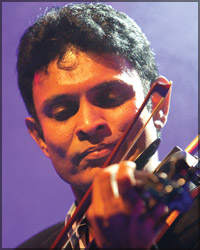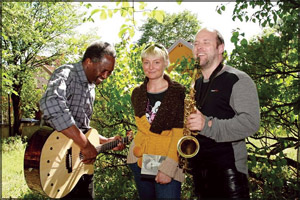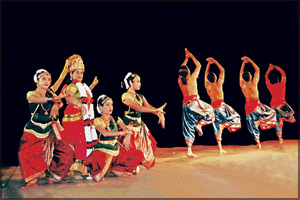Gripping spell of superior aesthetic exponents
Conglomerate of traditions and folk music:
by Indeewara Thilakarathne and Ranga Chandrarathne
[email protected]
“Traditions meet”, concert of Sri Lankan and Norwegian traditional
music was recently held at Ananda College auditorium. It was presented
by Concert Institute of Norway and Aru Sri Art Theatre Sri Lanka. The
curtain raises with the spell bounding performance by visiting Norwegian
troupe ‘Seven Winds’ with its energetic trio Becaye AW (Guitar),
Rolf-Erik Nystrom (Saxophone) and singer Unni Lovlid.
|

Ravibandu Vidyapathi |
They played authentic Norwegian traditional pieces some of which were
as old as thousand years. Unni is a leading folk singer from West coast
of Norway and Becaye originally from Mauritania is one of the best
African blues guitar player and joined with Rolf-Erik (Saxophonist) from
Norway.
Perhaps, the most enchanting among them were the composition on
themes like rain and movements of a bird. Although the audience could
not understand the beautiful poetry, composition of music really touched
one. At times, the high pitched voice of Unni dominated the silent
audience and at other times, it was Becaye AW’ guitar or Rolf-Erik
Nystrome’s Saxophone.
For Becaye, the guitar is like a playmate. He plays it with such fine
movements of fingers that it is really difficult to see the change of
strings and stressing of the strings. Rolf-Erik Nystrom with Saxophone
moves freely on the stage sometimes with closed eyes. Unni’s voice was
best at times when she sang traditional Norwegian songs, perhaps, true
to their original spirit. They have modified traditional folk songs to
suit the modern audience.
Following their performance, the visiting Norwegian troupe played
with Ravibandu Vidyapathy’s formidable drum orchestra. The item
‘Traditions meet’ was the most exciting moment of the concert. It was
not only a blend of diverse traditions from both Sri Lanka and Norway
but also confrontation of two cultures.
For the first two items, Becaye with guitar and Rolf-Erik Nystrom
with Saxophone joined the drum orchestra. The orchestra consisted of
talented Sri Lankan musicians including Ravibandu Vidyapathy (Sri Lankan
drums), Priyantha Dassanayake (Flute), Ruwan Weerasekara (violin) and V.
Jambunathan (Mrithangam player).
However, subsequently Unni joined with Sri Lankan folk singers Indika
Upamali and T. S. Murugesh. At first each singer representing Sinhala,
Tamil and Norwegian folk music sang solos in their distinctive
traditions. The climax of the item was marked when the trio sang
simultaneously, producing different colours of tone. At times, it was
rather a clash of traditions and all the traditions were mixed in a
chaos.
|

Ruwan Weerasekara' |
However, it would have been a challenge for Sri Lankan performers and
visiting Norwegian player as they had to concentrate intensely on
separate tunes whilst playing them in parallel with other traditions.
Perhaps, this would have been for the first time, the oriental folk
music met with its occidental counterpart in fusion music. Though
chaotic, at times, fusion of folk songs from traditions as diverse as
Sinhalese, Tamil and Norwegian is a bold attempt. It would have been a
challenging experience for visiting Norwegian troupe as well as for Sri
Lankan singers.
“Mathra”, a popular folklore group presented several items at the
concert. Singapore is about the aping of the West by Sri Lankans.
Reminding the audience of the colonial era where Sri Lankans were, for
the first time, exposed to Western civilization, through the enactment
of a drama with folk songs, Mathra highlighted the generation of Sri
Lankan who acquired culture and the mannerism of their colonial masters.
One of the modes of attacking this phenomenon was pinpointing a local
leader who mimics the mannerism of the departing British. The item
mainly focuses on embracing alien culture by Sri Lankans.
This class of people subsequently distinguished themselves from the
ordinary so they are the Singaporians. A significant aspect of the piece
was that Mathra has used original folk melodies and Viridu (traditional
Sinhalese ballad music) for the composition.
The local leader putting on the British hat pretended that he was
really ignorant of Sinhalese. This is a peculiar characteristic of the
certain section of the upper middleclass Sri Lankans who are really
proud to demonstrate their ignorance of native languages; Tamil or
Sinhalese.
|

Becaye AW (Guitar), singer Unni Lovlid and Rolf-Erik Nystrom
(Saxophone). |
Though there are genuine cases, majority of upper middle class men
and women’s professed ignorance of native languages and culture is a
sham.
Mathra is directed by Saman Panapitiya, singer, composer and lecturer
in the Department of Ethnomusicology at the University of Visual and
Performing Arts. Costumes for the items presented by “Mathra” were not
very soothing and the performance was also not up to the expectation.
They could surely have used more traditional flavour instead of
resorting to improvisation.
Tamil folk dance (gypsy dance) was one of the colourful items
presented by Aru Sri Art Theatre. It really depicted momentous
life-style of gypsy community. The performers captured the essence of
gypsy community in general and mannerism of the women in particular.
The other item took place on Kamatha (an oval shaped threshing floor
in a harvested paddy field). Oiraira Oirama reflects cultural alienism
of youth. Piece highlights youth culture which acquires and creates
traditions borrowed from the West is not squarely blamed for alienisms
but the entire population which had not practiced the indigenous
culture.
Indika Upamali’s performance was not the best and she was breathless
on several occasions. Audience expected much more from the otherwise
immensely gifted versatile singer.
Ravibandu together with his drum orchestra performed well.
|

Performers of the Aru Sri Art theatre |
However, the glamour created by Ravibandu’s actor like performance
with occasional nod was absent from the performance. This noticeable
absence contributed to lessen inspiration of the audience. The musical
cooperation between the two countries is achieved through transfer of
knowledge of music and competency development of music education of the
two countries.
As the theme and the focus was on folk music, the concert
concentrated on folk music. However, as a measure of breaking the
monotony of the show, two items mixed with dancing and songs from
Sinhalese and Tamil traditions of folk music have been introduced to the
show.
Deshanethru Kalasuri Arundathy Sri Ranganathan’s innovative ideas
coupled with Ravibandu’s percussion marvels and Saman Panapitiya’s
creativity contributed to the overall success of the concert.
It should be mentioned here that long years of teaching of the trio
coupled with practical precision enabled them to represent the authentic
traditions of Sri Lanka.
The concert concluded with an energetic performance by drum Orchestra
with Norwegian players Rolf-Erik and Becaye. Perhaps, it would be a
fitting finale as the Sri Lankan drums echoed in the auditorium.
The Traditions Meet offered a glimpse into the rich folk traditions
of Sri Lanka and Norway and commenced rich dialogue between the two
countries. |

